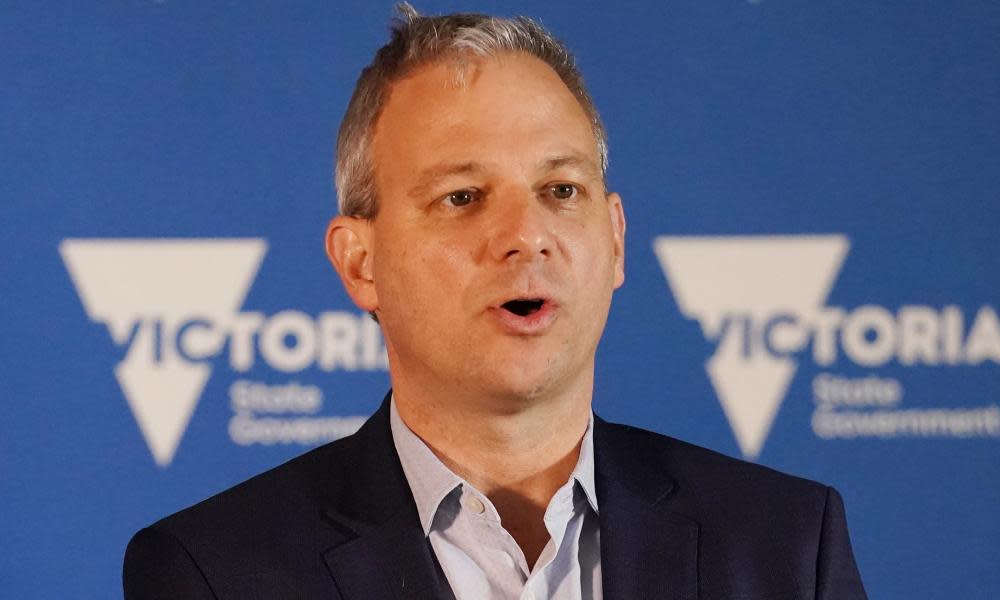Health officials 'hopeful' Australia is flattening coronavirus curve but warn against complacency

Health authorities in Australia have expressed cautious optimism that Australia may be able to limit the domestic coronavirus outbreak, as the death toll reaches 34 including three more deaths linked to the Ruby Princess cruise ship.
However, senior officials have warned against complacency or relaxing social distancing rules too early.
Australia’s chief medical officer Professor Brendan Murphy said the number of cases in Australia rose by 139 on Sunday, to a total of 5,687 cases. About 2,000 of those cases are of people who have completely recovered.
“That is probably the lowest rise we’ve had for a few days and it does tend to continue the trend we’ve seen of flattening of the curve,” Murphy said.
He added: “We’re increasingly confident that if people continue to adhere to what we’ve been asking them to do we can prevent a situation like we’ve seen in many other country of the world.”
However Murphy said he remained concerned about community transmission, which accounted for 10% of cases in Australia.
The deputy chief medical officer, Nick Coatsworth, meanwhile said Australia appeared to be on the right path.
“If we do stop these measures too early, then we have seen graphs in the media showing there could be a resurgence in cases so we have to be careful on those grounds,” Coatsworth told Sky News on Sunday.
Related: 'Like preparing for war': Australia's hospitals brace for coronavirus peak
Dr Jeremy McAnulty, NSW Health’s director of health protection, said the rate of daily infections in that state was “stabilising” but it was too early to say if this trend would continue.
“It is pleasing to see early signs of stabilisation, which is down to a number of important factors,” McAnulty said.
He attributed that stabilisation to an early detection of cases, allowing for early contact tracing and isolation of all known contacts, as well as adherence to social distancing measures.
“We want to be hopeful, but not to over-egg the figures,” he said. “The last few days we have seen numbers bounce around without escalating at the same level as we have seen before, so we are hopeful that we are starting to flatten the curve. But there is more work to be done and it is important that we all heed those messages.”
New South Wales reported 87 new cases on Sunday, bringing the total number of cases in that state to 2,580. Some 39 people with Covid-19 are in intensive care in that state, 23 of whom require ventilators.
NSW has the highest rates of untraced community transmission in the country, with 380 cases recorded as having been acquired locally with no known source of infection and 58 more under investigation. About 118,863 people have tested negative to the virus .
The federal government has said it will release modelling on the coronavirus outlook in Australia on Tuesday, after it is approved by the national cabinet.
Modelling by the University of Sydney showed that the number of active cases in Australia, assuming continued adherence to the current social distancing laws, could peak mid-April and the spread could be controlled by July. That modelling suggested the total number of people who would contract Covid-19 in Australia over the course of the pandemic was between 8,000 and 10,000. The current number is 5,635.
Victoria’s chief health officer, Prof Brett Sutton, said he for the first time had “a little bit of optimism that we can actually beat this”.
“That we can take a different course than most of Europe and North America has taken,” Sutton said. “That we can avoid literally the millions of cases that will occur in North America and Europe and the tens of thousands of deaths that, unfortunately, will occur in those continents … It means staying the course in Australia, and the things that we’ve asked people to do can make a difference, and this is the very early sign of it.”
Victoria recorded 20 new cases of Covid-19 overnight, bringing the total to 1,135 of which 75 were acquired through untraced community transmission.
Sutton said the new cases recorded on Sunday were “likely to be a mix” of returned travellers and known contacts, and community acquired cases.
Related: NSW health minister defends experts who handled Ruby Princess coronavirus outbreak
“We’ll see a greater proportion of community transmission as our international travel proportion goes down, because those individuals are smaller and smaller in number as every day goes by,” he said. “And their secondary contacts are fewer and fewer because we’ve got people in hotel quarantine, therefore protecting others around them.”
Queensland recorded just nine new cases overnight – its smallest one day rise in weeks.
“We’ve got a long way to go, but these signs are very encouraging to have only nine positive cases overnight,” Queensland premier Annastacia Palaszczuk said.
Palaszczuk said that more than 92% of the 907 cases confirmed to date in Queensland were either acquired overseas, or were caught from a person who had acquired the disease overseas.
The Northern Territory has no confirmed cases of community transmission. It recorded 27 new cases overnight, including a child who was a close contact of a person who had travelled overseas.

 Yahoo News
Yahoo News 
